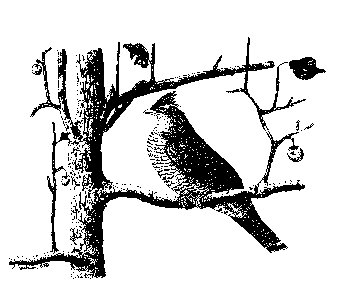Rejuvenating Old Apple Trees
Why Care About Old Apple Trees?
Wild apple trees are one of the most important wildlife food plants in New England. They are used by many wildlife species, including white-tailed deer, ruffed grouse, snowshoe hare, cottontail rabbit and gray squirrel. Apples or apple seeds have been found in the stomachs of fox, fisher, porcupine, bobcat and red squirrel. Apple trees also provide good habitat for woodcock and many songbirds, including bluebirds, flycatchers, robins and orioles. New England is fortunate to have apple trees growing naturally in the wild.
Where Are Old Apple Trees Found?
Wild apple trees normally become established in clearings or on the edges of fields. Eventually, forests will grow and surround established apple trees, often crowding the trees and shading them from sunlight. Prolonged periods of crowding and shading will cause a decline in vigor and eventually death to the trees, decreasing their value to wildlife.
Pruning an Old Apple Tree
The health, location and value of an apple tree should be determined before pruning is done. If the trunk is rotten and appears to be split or if there are only one or two healthy branches, the tree may not be worth saving. Trees that are successful in producing fruit are exposed to the sun all day long. Disease and insects are more likely to affect trees located in a shady, damp area.
First efforts should be aimed at clearing around the tree, so that the leaves and fruit get plenty of exposure to sunlight. In a situation where the tree has grown in a competitive forest, the apple tree should be pruned before competing trees are cleared from the area. Trees growing under these circumstances usually have shallow root systems and are easily wind blown.
Pruning should be done in late winter or early spring before the leaves begin to appear. When there are no leaves on the branches, it is easier to see the structure of the tree and what cuts are necessary. By late winter, the tree is fully dormant and less susceptible to injury. Also, it has a chance to form a protective barrier behind the pruning cuts before insect and disease organisms become active.
Up to one-third of the live wood on an apple tree can be removed each year. If a tree has been abandoned for a long time, cut only diseased and damaged branches before removing one-third of the live wood. In a situation where the whole top needs to be cut off, the tree will be highly stressed and may not produce apples for a few years.
Pruning Guidelines
The following pruning rules will help improve the vigor and productivity of an old apple tree.
- Remove all dead wood and diseased branches. All diseased and insect-infested wood should be burned to prevent reinfestation. Coat cutting tools with bleach between cuttings to help prevent reinfestations.
- Prune more heavily in the upper part of the tree than in the lower. Sunlight will spread more evenly throughout the tree, helping to maintain the productivity of the lower limbs.
- Take out branches that grow toward the center of the tree. This also allows sunlight to reach the fruit.
- Cut out branches with narrow crotches. Narrow crotches are weak, causing branches heavy with fruit to split.
- Remove all vertical growth. Upright branches do not produce fruit. Cut out water sprouts; these are fast-growing, unbranching upright shoots.
- Encourage horizontal branches since they tend to bear more fruit. Branches at a 45 or 90 degree angle are the most desirable.
- Eliminate branches that hang below or across one another. A branch shaded by an upper one is not likely to be productive.
- Cut back drooping branches. Cutting a branch will strengthen it by encouraging growth further back along the branch.
 The Technical Assistance Informational Series is 75 percent
funded by Federal Aid to Wildlife Restoration - Pittman-Robertson (P-R) Program. The P-R
Program provides funding through an excise tax on the sale of sporting firearms,
ammunition, and archery equipment. The remaining 25 percent of the funding is matched by
the Connecticut Wildlife Division. (rev. 12/99)
The Technical Assistance Informational Series is 75 percent
funded by Federal Aid to Wildlife Restoration - Pittman-Robertson (P-R) Program. The P-R
Program provides funding through an excise tax on the sale of sporting firearms,
ammunition, and archery equipment. The remaining 25 percent of the funding is matched by
the Connecticut Wildlife Division. (rev. 12/99)

